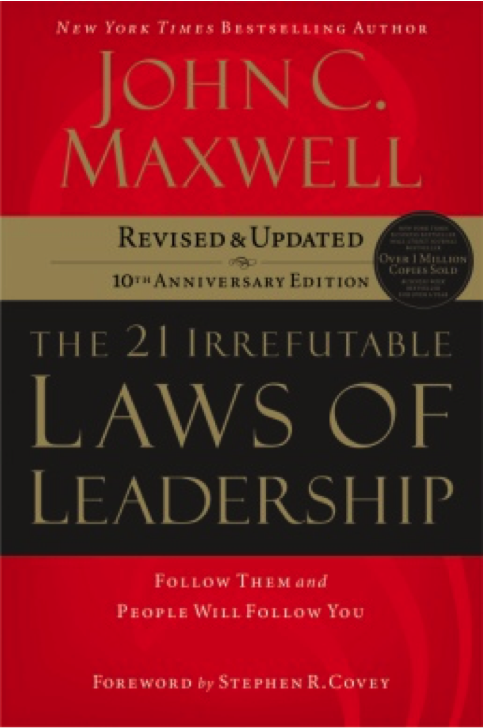October 2016: In This Issue
Welcome to the October issue of A New Leaf!
The current fourth quarter provides LEADERS with unique challenges as they strive to finish 2016 on a high note. Depending on your results to date, you may be focused on maintaining the strong momentum for the rest of the year or on rallying the troops to salvage a positive fourth quarter. In either case, "The 21 Irrefutable Laws of Leadership" by John Maxwell summarized below will provide constructive guidance on successfully fulfilling your leadership role.
The upcoming months also provide you with a LEADERSHIP opportunity to direct your team in assessing their current STRATEGY and the dynamic changes required to enhance their competitiveness. Your decision making process during this important exercise will set the stage for success or status quo in 2017.
I recently had the privilege to meet John Maxwell and his team during a full week certification program. The week was highlighted by a lengthy presentation by Maxwell on the decision making challenges he faced when asked to be a 3rd party candidate in the current presidential election. His process included reference to a number of his own irrefutable laws that convinced him that the opportunity was not right…for now. Maxwell's decision making process mirrors what you likely will be facing in your upcoming STRATEGY setting process.
Best of luck as you work to be intentional in addressing your LEADERSHIP and STRATEGY challenges. Your success and that of your team depends on your ability to raise your own leadership "lid" (see below) that may represent a significant limiting factor on your organization's effectiveness.
Mike
Book Summary: "The 21 Irrefutable Laws of Leadership"
by John Maxwell

John Maxwell's influence on Leadership is unparalleled. He has been acclaimed as the Most lnfluential Leadership Expert by Inc. magazine, voted #1 Leader in Business by the American Management Association and recognized as the #1 New York Times best - selling author, coach and speaker. He has sold over 25 million books in fifty languages. This month's book summary is of his most popular and influential book "The 21 Irrefutable Laws of Leadership" (21 Laws).
21 Laws dedicates a chapter to each law sharing its foundation and real life examples where it has made a substantial leadership impact. The book also includes a self evaluation providing every leader with the ability to assess where they may be strong or in need of improvement. Taking this evaluation is important as Maxwell notes that the "leadership principles are unchanging and have stood the test of time and cultures". Maxwell offers early that "the greater number of laws you learn, the better leader you will become". He provides comfort to readers that each of the 21 Laws:
- Can be learned - that every one of them can be acquired with focus and attention
- Can stand alone - that you don't need to master one in order to learn another
- Carry consequences with them - If you choose to violate or ignore them, you will not be able to lead others
- Are the foundation of leadership - once you learn them, you have to practice and apply them to be successful
Following is an overview of The Law of the Lid and The Law of the Inner Circle. These are followed by a brief summary of each of the 21 Laws.
Law #1 - The Law of the Lid:
In this very first law, Maxwell states that "a person's leadership ability is the lid that determines their overall success". More importantly, "your leadership ability - for better or worse - always determines the effectiveness of and the potential of your organization". If your leadership lid rates an 8, then your effectiveness, and that of your organization, can never be greater than a 7. If your leadership is only a 4, then your organization will never be greater than a 3.
This law has far reaching implications for the leader who does not believe that their personal development is critical to the success of their organization. Absent a leader taking actions each year to "raise their lid" through self development, their organization is bound for mediocrity.
Maxwell shares two stories illustrative of this important law; the first relating to two brothers who launched a new, fast food concept in California. Due to their low lids, they were forced to sell the successful concept to the owner of a small supplier to the company. The buyer had a much higher lid leading to greater leadership effectiveness that allowed him to take this organization, now known as McDonalds, to levels never imagined by the original founders. The lack of leadership ability proved to be the lid on the McDonald brother's success.
Maxwell's second story pertained to the Chairman of a Hotel Company who, upon acquiring an underperforming property, would always take the same first step; fire the owner. The Chairman had great clarity that "if he'd been a good leader, the organization wouldn't have been in the mess they were in". Upon assessment of this strategy, Maxwell concluded this was finely tuned execution of his "Law of the Lid". The good news, contrary to this Chairman's opinion, is that every leader can raise his lid…..if he so desires. This personal growth is significantly impacted by Law # 11 detailed below.
Law #11 - The Law of the Inner Circle:
Maxwell begins this revealing chapter by affirming that leader's do not succeed alone. A leader's potential is determined by those closest to them. What makes the true difference in a leader's effectiveness is the strength of their "inner circle".
Maxwell shares that "no single leader can do all 21 things well". That's where an inner circle with varied strengths and capabilities come in. "There are no Lone Ranger leaders….if you're alone, you're not leading anybody".
All leaders ultimately create an inner circle. Most are not strategic about the process. Many surround themselves with people they like or are comfortable with. To execute the "Law of the Inner Circle", leaders must be intentional about their relationship building. Only if a leader reaches their own potential do their people have a chance to reach theirs.
Maxwell sets forth the following questions to assess as a leader identifies inner circle candidates:
- Do they have high influence with others (exercising Law #2)?
- Do they bring a complementary gift to the table?
- Do they hold a strategic position in the organization?
- Do they add value to me and to the organization?
- Do they positively impact other inner circle members?
A yes assessment is not required to every question above. The following question is the only one identified by Maxwell where a "no" response would exclude a candidate from "inner circle" consideration:
- Do they display excellence, maturity, and good character in everything they do?
Maxwell concludes the 21 Laws sharing the following keys to building a successful organization:
- Personnel determine the potential of the organization
- Relationships determine the morale of the organization
- Structure determines the size of the organization
- Vision determines the direction of the organization
- Leadership determines the success of the organization
Now that you know the 21 Laws, share them with your team. Take each of the laws seriously and model the way for others to follow. Raising your lid each and every year is an integral part of moving your leadership…and organization…forward.
Overview of the 21 Laws:
- The Law of the Lid - Leadership ability determines a person's level of effectiveness
- The Law of Influence - The true measure of leadership is influence - Nothing more, nothing less
- The Law of Process - Leadership develops daily, not in a day
- The Law of Navigation - Anyone can steer a ship, but it takes a leader to chart the course
- The Law of Addition - Leaders add value by serving others
- The Law of Solid Ground - Trust is the foundation of leadership
- The Law of Respect - People naturally follow leaders stronger than themselves
- The Law of Intuition - Leaders evaluate everything with a leadership bias
- The Law of Magnetism - Who you are is who you attract
- The Law of Connection - Leaders touch a heart before they ask for a hand
- The Law of the Inner Circle - A leader's potential is determined by those closest to him
- The Law of Empowerment - Only secure leaders give power to others
- The Law of the Picture - People do what people see
- The Law of Buy In - People buy into the leader, then the vision
- The Law of Victory - Leaders find a way for the team to win
- The Law of the Big Mo - Momentum is a leader's best friend
- The Law of Priorities - Leaders understand that activity is not necessarily accomplishment
- The Law of Sacrifice - A leader must give up to go up
- The Law of Timing - When to lead is as important as what to do and where to go
- The Law of Explosive Growth - To add growth, lead followers. To multiply, lead leaders
- The Law of Legacy - A leader's lasting value is measured by succession


